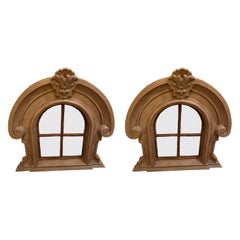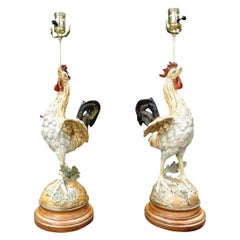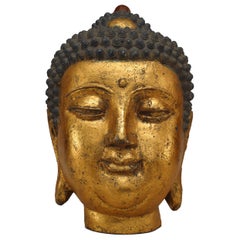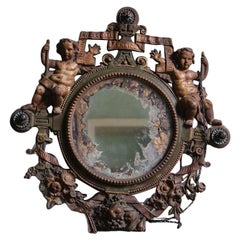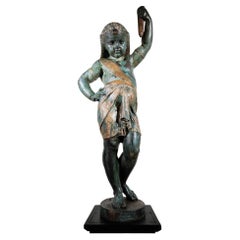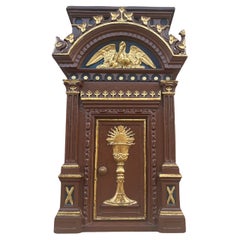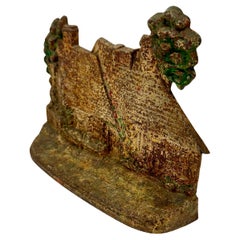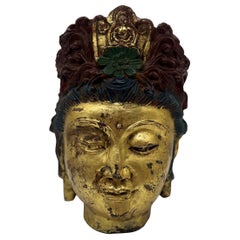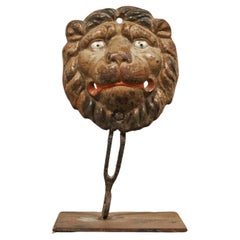Polychrome Cast Iron
Antique 19th Century French Napoleon III Architectural Elements
Iron
Vintage 1920s French French Provincial Table Lamps
Iron
20th Century Chinese Export Busts
Iron, Wrought Iron
Antique 19th Century English Victorian Wall Mirrors
Glass
Antique Late 19th Century Statues
Wrought Iron
Antique 19th Century European Empire Revival Cabinets
Iron
Antique Late 19th Century American Folk Art Architectural Elements
Iron
Antique 19th Century Tibetan Busts
Iron, Gold Leaf
Antique 19th Century European Antiquities
Iron
Antique Early 1900s French Wall Lights and Sconces
Iron
Antique 16th Century Chinese Ming Sculptures and Carvings
Iron
Antique 1870s American Architectural Elements
Iron
20th Century Neoclassical Console Tables
Cast Stone, Brass, Iron
Antique 19th Century European Folk Art Sculptures and Carvings
Iron
20th Century American Animal Sculptures
Iron
Antique 19th Century Historical Memorabilia
Iron
Antique 1890s French Louis XV Fireplace Tools and Chimney Pots
Iron
Late 20th Century Neoclassical Floor Lamps
Travertine, Marble, Metal
Antique Early 19th Century English Regency Music Stands
Brass
Antique 1880s English Andirons
Iron
Early 20th Century American Bookends
Iron
Early 20th Century American Paperweights
Iron
Early 20th Century Paperweights
Brass
Mid-20th Century American Mid-Century Modern Bookends
Metal, Iron
Mid-20th Century Folk Art Table Clocks and Desk Clocks
Metal
Antique 1780s American Folk Art Painted Furniture
Iron
Antique Early 19th Century French Victorian Wall-mounted Sculptures
Wrought Iron
Antique 1820s American Folk Art Painted Furniture
Iron
Vintage 1920s American Victorian Wall Lights and Sconces
Iron
Vintage 1960s Dutch Mid-Century Modern Table Lamps
Steel, Iron
Mid-20th Century American Art Deco Chandeliers and Pendants
Iron
Antique Late 19th Century Toys and Dolls
Iron
Early 20th Century Toys and Dolls
Iron
Early 20th Century American Figurative Sculptures
Iron
Early 20th Century American Animal Sculptures
Iron
Early 20th Century American Figurative Sculptures
Iron
Early 20th Century American Classical Political and Patriotic Memorabilia
Iron
20th Century Planters, Cachepots and Jardinières
Iron
Antique 19th Century Animal Sculptures
Iron
Antique 1890s American Folk Art Toys
Iron
Antique 19th Century German Decorative Objects
Iron
Antique 19th Century English Sculptures
Antique 19th Century European Figurative Sculptures
Iron
Antique 19th Century French French Provincial Umbrella Stands
Iron
Antique Late 19th Century British Victorian Antiquities
Iron
Antique 1840s English William IV Animal Sculptures
Iron
Early 20th Century Art Deco Chairs
Wrought Iron
Vintage 1910s French Art Nouveau Gueridon
Marble, Brass, Iron
Antique 19th Century Umbrella Stands
Wrought Iron
20th Century American Toys and Dolls
Metal, Iron
20th Century American Toys and Dolls
Metal, Iron
20th Century American Toys and Dolls
Metal, Iron
Antique Late 19th Century American American Colonial Toys and Dolls
Iron
Antique Late 19th Century French Mantel Clocks
Vintage 1920s Japanese Taisho Sculptures and Carvings
Iron
Vintage 1970s Italian Mid-Century Modern Table Lamps
Metal, Iron
Early 20th Century English Umbrella Stands
Early 20th Century American Edwardian Chandeliers and Pendants
Iron
- 1
Polychrome Cast Iron For Sale on 1stDibs
How Much is a Polychrome Cast Iron?
- 1stDibs ExpertMay 3, 2024The difference between iron and cast iron comes down to content. Iron is generally pure iron, a chemical element that is a solid metal at room temperature. Cast iron is a mix of iron, carbon, silicon, manganese, sulfur, phosphorus and other elements. Both iron and cast iron can be used to produce furniture, cookware, decorative objects and other items. Generally, cast iron is heavier than iron. Shop an assortment of iron and cast iron pieces on 1stDibs.
- Who invented cast iron?1 Answer1stDibs ExpertMay 3, 2024The name of the person who invented cast iron is unknown. However, anthropologists and archaeologists have determined that the ancient Chinese were the first to develop it. The earliest known examples of cast iron date back to the 6th century B.C. Cast iron production didn't begin in Europe until the 14th century A.D. Shop a collection of cast iron furniture and decorative objects on 1stDibs.
- What are cast iron columns?1 Answer1stDibs ExpertMay 5, 2023Cast iron columns are vertical supports produced out of cast iron, a material made from iron and alloys with a carbon content of more than two percent. During the 19th century, cast iron columns were used in architecture. Today, they primarily function as decorative objects. Shop a range of cast iron columns on 1stDibs.
- Are cast iron columns hollow?1 Answer1stDibs ExpertMarch 31, 2023Whether cast iron columns are hollow depends on the piece. Most cast iron columns are hollow due to the manner of crafting, but some are solid. On 1stDibs, find a selection of columns.
- 1stDibs ExpertFebruary 17, 2023Yes, you can generally use cast iron as a planter because the material is durable and sturdy. However, you may need to drill drainage holes in a cast iron piece that wasn't intended to function as a planter to allow excess water to exit the vessel. On 1stDibs, find a selection of cast iron planters.
- 1stDibs ExpertSeptember 25, 2019
To keep a piece made of cast iron from rusting, place it in a cool, dry space with good air circulation.
- How do I hang a cast iron bell?1 Answer1stDibs ExpertMarch 22, 2022How to hang a cast iron bell depends on the style. Some cast iron bells have loops at the top that you can hang from a hook anchored onto your desired mounting surface. Others have brackets or frames that you can secure with mounting screws. On 1stDibs, shop a selection of cast iron bells.
- 1stDibs ExpertAugust 17, 2021Cast iron trivets are used for many things but are especially ideal for slow cooking meat. They can prop up food in Dutch ovens to prevent burning and increase heat distribution.
- 1stDibs ExpertSeptember 25, 2019
Cast iron is stronger than steel.
- 1stDibs ExpertMarch 22, 2022Cast iron doorstops originated in the late 18th century. Osbourn Dursey invented the first doorstop in 1878. Decorative cast iron stops became popular in the 1920s and remained so throughout World War II. On 1stDibs, shop a variety of antique cast iron doorstops.
- Do cast iron tables rust?1 Answer1stDibs ExpertMay 5, 2023Yes, cast iron tables can rust. Pieces are more likely to develop rust when exposed to humidity, such as in bathrooms or outdoor living spaces in coastal areas. Wiping surfaces clean regularly and touching up scratches and chips can reduce the risk of rust. On 1stDibs, shop a selection of cast iron tables.
- Do cast iron Firebacks work?1 Answer1stDibs ExpertAugust 24, 2021Yes, cast iron firebacks are quite sturdy and work really well. As they are made of solid iron, it's a challenge to move and place them. Given that, cast iron firebacks are the best protection for the back wall of the fireplace. Find a variety of firebacks on 1stDibs.
- 1stDibs ExpertMarch 22, 2022A cast iron fireplace insert is a firebox that fits into an existing fireplace surround. The insert is made of cast iron, a type of iron that is more than 2 percent carbon. Cast iron is highly durable and very resistant to the effects of heat. You'll find a selection of cast iron fireplace inserts on 1stDibs.
- When were cast iron beds made?1 Answer1stDibs ExpertFebruary 22, 2021Cast iron beds were made starting in the 1850s. These types of beds were handmade until World War I through the use of molds.
- Does cast-iron furniture rust?1 Answer1stDibs ExpertSeptember 25, 2019
Yes, cast-iron furniture rusts.
- 1stDibs ExpertMarch 31, 2023Cast iron is often used for benches because of its characteristics. Its strength makes it well-suited to support the weight of two or more adults, and its hardness allows it to resist damage due to weather exposure. Shop a range of cast iron benches on 1stDibs.
- 1stDibs ExpertApril 5, 2022Cast iron is frequently used for fireplaces due to its properties. The metal is highly durable, allowing it to hold up to the effects of frequent use. It also readily conducts heat to help warm up interiors. You'll find a variety of cast iron fireplaces on 1stDibs.
- 1stDibs ExpertSeptember 25, 2019
Unlike cast iron, wrought iron is not brittle and will bend rather than break. Wrought ironwork is produced with a hammer and anvil and tends to be more intricate than cast ironwork, which is characterized by repetitive designs that can be carved into a wooden pattern and cast.
- 1stDibs ExpertJune 30, 2023To tell if a cast iron doorstop is valuable, always look for original paint. Any that have been repainted or repaired will have diminished in value. You can also use online resources to try and research items, but the best way to find out if a cast iron doorstop is worth anything is to consult a certified appraiser. An experienced professional can evaluate the condition, determine the maker and research the piece to assign an approximate value. On 1stDibs, find a range of doorstops.
- 1stDibs ExpertMay 5, 2023Whether cast iron is good for outdoor furniture is largely a matter of personal opinion. However, many people prefer cast iron due to its strength, durability and timeless Old World charm. On 1stDibs, find a collection of cast iron outdoor furniture.
